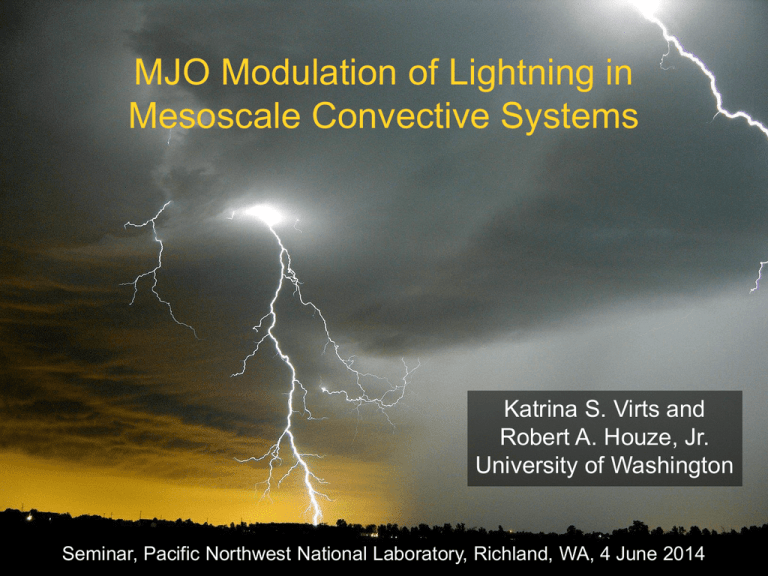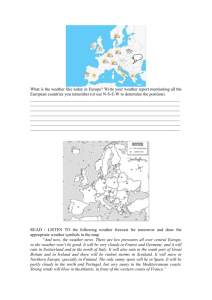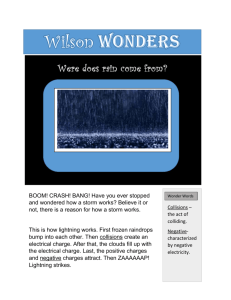MJO Modulation of Lightning in Mesoscale Convective Systems
advertisement

MJO Modulation of Lightning in Mesoscale Convective Systems Katrina S. Virts and Robert A. Houze, Jr. University of Washington Seminar, Pacific Northwest National Laboratory, Richland, WA, 4 June 2014 Mesoscale Convective Systems (MCSs) Radar echoes showing the precipitation in the 3 MCSs Stratiform Precipitation Convective Precipitation Madden-Julian Oscillation Intraseasonal time scales (~30-80 days) Enhanced convection develops over equatorial Indian Ocean Eastward propagation Associated circulation anomalies Image courtesy Madden and Julian (1972) MJO modulation of cloud population Field campaigns (TOGA COARE, DYNAMO/AMIE) Satellite observations – Passive sensors • “Superclusters” (Nakazawa 1988) • MJO “modulates cloud clusters of all sizes, but larger clusters are proportionately more affected than smaller clusters” (Mapes & Houze 1993) • MJO “associated with weaker or stronger mesoscale organization of deep convection” (Tromeur & Rossow 2010) MJO modulation of cloud population Satellite observations (continued) – TRMM • Shallow cumulus and congestus prior to onset of deep convection (Benedict & Randall 2007) • “The precipitating cloud population of the Madden-Julian Oscillation over the Indian and western Pacific Oceans” (Barnes and Houze 2013) – CloudSat • “A familiar evolution of cloud type predominance” (Riley et al. 2011) • “Shallow and congestus clouds in advance of the [MJO] peak, deep clouds near the peak, and upper level anvils after the peak” (Del Genio et al. 2012) – Other A-Train satellites (Yuan and Houze 2013) MJO modulation of cloud population (Barnes and Houze 2013) Echo types: – Isolated shallow echoes (ISEs) — echo tops at least 1 km below freezing level – Deep convective cores (DCCs) — radar echo ≥ 30 dBZ up to at least 8 km – Wide convective cores (WCCs) — radar echo ≥ 30 dBZ covering at least 800 km2 – Broad stratiform regions (BSRs) — stratiform echo covering at least 50,000 km2 Indian Ocean NW Western Pacific SE Western Pacific Image courtesy Barnes and Houze (2013) MJO modulation of lightning Out of phase with rain (Morita et al. 2006) Image courtesy Morita et al. (2006) MJO active MJO inactive Image courtesy Kodama et al. (2006) MJO modulation of lightning Break period (phases 8-1-2) minus active period (phases 4-5-6) Image courtesy Virts et al. (2013) Out of phase with rain (Morita et al. 2006) Suppressed over large islands during active period (Kodama et al. 2006) Modulation of diurnal cycle (Virts et al. 2013) MJO modulation of lightning Break period (phases 8-1-2) minus active period (phases 4-5-6) Image courtesy Virts et al. (2013) Out of phase with rain (Morita et al. 2006) Suppressed over large islands during active period (Kodama et al. 2006) Modulation of diurnal cycle (Virts et al. 2013) What about individual convective clouds? Identifying MCSs using A-Train data MODIS 10.8 m brightness temperature AMSR-E rain rate Years included: 2007-2010 Details in Yuan and Houze 2010 260K Separated HCS Details in Yuan and Houze 2010 260K Closed contour Separated HCS Details in Yuan and Houze 2010 260K Closed contour Separated HCS “HCS” Details in Yuan and Houze 2010 260K Heavy Rain Closed Rain contour Separated HCS “HCS” Details in Yuan and Houze 2010 “Separated” Separated HCSMCS active 260K Heavy Rain Closed Rain contour “HCS” “Connected” active MCS Details in Yuan and Houze 2010 World-Wide Lightning Location Network (WWLLN) Global network of 70+ sensors Monitors very low frequency waves Lightning strokes located to within 5 km and a few s Preferentially detects cloud-to-ground lightning World-Wide Lightning Location Network (WWLLN) Lightning in one-hour window – Separate coordinate system for each MCS, centered on largest raining core – Lightning in cloudy grid boxes (lightning density) Indian Ocean % CMCSs MCS lightning density 29.5 Maritime Continent 17.6 Western Pacific 30.0 SPCZ 29.3 Indian Ocean Maritime Continent Western Pacific SPCZ % CMCSs 29.5 17.6 30.0 29.3 MCS lightning density 2.9 26.5 2.5 7.6 CMCSs most frequent with peak precip. SMCS timing varies, reflects MJO stage CMCSs experience greater variability MJO modulation of lightning in Maritime Continent SMCSs More frequent lightning, broader lightning maximum during break period Lifted Index (LI) Measure of lower-tropospheric stability LI = Te ( p) - Tp ( p) Negative LI parcel warmer than environment Calculate using ERA-Interim fields MCS environments more unstable during break period MJO modulation of lightning density Peak lightning at end of break period SPCZ: peak lightning at beginning of break period Lower lightning density in CMCSs TRMM radar precipitation features (RPFs) Contiguous areas with near-surface rain rate > 0 Use features with maximum 30 dBZ height > 6 km Size equivalent to smallest and largest 50% of MCSs Years included: 1998-2012 RPF data obtained from University of Utah TRMM database. Details in Liu et al. 2008 TRMM radar precipitation features (RPFs) Contiguous areas with near-surface rain rate > 0 Use features with maximum 30 dBZ height > 6 km Size equivalent to smallest and largest 50% of MCSs Years included: 1998-2012 convective rain volume convective rain fraction = convective + stratiform rain volume RPF data obtained from University of Utah TRMM database. Details in Liu et al. 2008 MJO modulation of convective rain fraction Peak at end of break period Varies strongly with RPF size MJO modulation of MCS characteristics Isolated deep convection begins to aggregate – Strong instability strong updrafts more lightning – Dry mid/upper troposphere smaller stratiform areas MCSs become more numerous – Stability increases less lightning – Increasingly extensive stratiform rain areas MCSs increasingly more connected – CMCS occurrence peaks with precipitation MCSs decrease in number, size, connectedness – Smaller stratiform areas rain is more convective – Increasing instability during break period more lightning MJO modulation of MCS characteristics Isolated deep convection begins to aggregate – Strong instability strong updrafts more lightning – Dry mid/upper troposphere smaller stratiform areas MCSs become more numerous – Stability increases less lightning – Increasingly extensive stratiform rain areas MCSs increasingly more connected – CMCS occurrence peaks with precipitation MCSs decrease in number, size, connectedness – Smaller stratiform areas rain is more convective – Increasing instability during break period more lightning MJO modulation of MCS characteristics Isolated deep convection begins to aggregate – Strong instability strong updrafts more lightning – Dry mid/upper troposphere smaller stratiform areas MCSs become more numerous – Stability increases less lightning – Increasingly extensive stratiform rain areas MCSs increasingly more connected – CMCS occurrence peaks with precipitation MCSs decrease in number, size, connectedness – Smaller stratiform areas rain is more convective – Increasing instability during break period more lightning MJO modulation of MCS characteristics Isolated deep convection begins to aggregate – Strong instability strong updrafts more lightning – Dry mid/upper troposphere smaller stratiform areas MCSs become more numerous – Stability increases less lightning – Increasingly extensive stratiform rain areas MCSs increasingly more connected – CMCS occurrence peaks with precipitation MCSs decrease in number, size, connectedness – Smaller stratiform areas rain is more convective – Increasing instability during break period more lightning MJO modulation of MCS characteristics (simplified) Few MCSs, mainly shallow or isolated deep convection “Younger” MCSs with strong convection “Older” MCSs with mature stratiform rain areas Familiar… Similar evolution in 2-4 day waves during MJO active period Image courtesy Zuluaga and Houze (2013) Stretched building block model (Mapes et al. 2006) Convective clouds and MCSs “in different stages of a largescale wave have different durations of shallow convective, deep convective, and stratiform anvil stages in their life cycles,” such that evolution of mean characteristics of convective clouds aligns with the evolution of individual clouds. Conclusions MCSs over land contain more vigorous convection, more lightning MCSs over the ocean are more connected Larger, more connected, and more numerous MCSs during MJO active period Peak lightning and convective rain fraction just prior to active period (except over SPCZ) Evolution of mean MCS characteristics aligns with MCS lifecycle (stretched building block) This work was funded by NASA (# NNX13AQ37G) and the Department of Energy (#DE-SC0008452).








